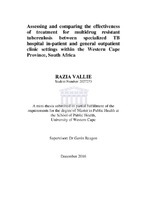| dc.description.abstract | Background: Multidrug resistant tuberculosis (MDR TB) is a growing threat
globally. The large increase in the incidence and prevalence of MDR TB in
South Africa in recent years has impacted on the way in which MDR TB is
managed within the health services. It became logistically difficult to manage
MDR TB by treating all patients as in-patients in a specialized tuberculosis
(TB) hospital. The clinics, which are run by nurses and/or general medical
officers, are then required to manage this more complex form of TB, with
limited resources, less experience and assumingly with less MDR TB
knowledge. Of particular concern is that shifting of the patient management
from specialized TB hospitals to Primary Health Care clinics which might
worsen the already poor MDR TB treatment outcomes. There has been minimal
assessment of the management of MDR TB at clinic level and hence the
comparison of treatment outcomes for those patients initiated on treatment in
clinics compared to in-patients in specialized TB hospitals is urgently needed.
Aim: To compare the treatment outcomes and the effectiveness of medication
regimens provided to MDR TB patients initiated on treatment in specialized TB
hospitals as inpatients, to that of MDR TB patients initiated on treatment as
outpatients at community clinics within the Western Cape Province, South
Africa.
Methodology
Study Design: A retrospective cohort study was undertaken, as the length of
treatment for a MDR TB patient can be for 24 months or longer and this study
was based on treatment outcome data.
Study Population and sample: The study population was uncomplicated MDR
TB patients initiated on treatment in hospitals and clinics from January 2010 to
December 2012. The sample comprised of 568 participants that were laboratory
confirmed to have MDR TB and had the outcomes of their treatment recorded
in an electronic database or a paper register.
Data Collection: The researcher collected MDR TB information from
standardized MDR TB registers as well as an electronic MDR TB database.
Analysis: Data was analyzed comparing the exposed (clinic initiated) and
unexposed (hospital initiated) cohorts incidence of 4 key treatment outcomes,
namely: successfully treated, failed treatment, died and defaulted treatment.
Bivariate analysis (relative and absolute) was done to determine the cumulative
incidence ratio and cumulative incidence difference and multivariate logistic
regression analysis for the adjusted odds ratio to control for confounders and
effect modifiers.
Ethics: Permission to conduct this research was obtained from the relevant
authorities. The confidentiality of the participants as per the Department of
Health policy and in adherence to general ethical guidelines was strictly
maintained. The study proposal received ethical clearance and approval from
the University of the Western Cape Research Committee.
Results: All participants within this study received the appropriate treatment as
per the MDR TB guidelines. The incidence rate for the main outcomes of this
study indicated that successfully treated for the clinic initiated participants was
41% and 31% for the hospital initiated participants. ‘Defaulted’ treatment was
39% and 41%, ‘failed’ treatment 7% and 13% and ‘died’ was 14% and 16%,
respectively. The clinic initiated participants appeared to have better treatment
outcomes on bivariate analysis, however on multivariate analysis, there was no
difference in the treatment outcomes of the clinic initiated participants
compared to the hospital initiated participants, and therefore the clinic initiated
treatment is seen as effective. The time to treatment initiation for clinic and
hospital initiated participants is excessively long for both cohorts, with a
median of 29 days, and 37 days respectively. The key findings of note in the
multivariate analysis is that the Human Immunodeficiency Virus positive
(HIV+) participants provided with antiretrovirals therapy (ART) were, based on
adjusted cumulative incidence ratios, 6.6 times more likely to have a
successfully treated outcome (95% CI 1.48-29.84), and were 0.2 times less
likely to die (95% CI 0.08-0.53). Having a previous cured history of TB and no
previous history of TB were 2.9 times more likely to have a successfully treated
outcome (95% CI 1.48-5.56) and were 0.1 times (0.04-0.38) less likely to fail
treatment. An interesting finding was that participants living in the rural
districts were 2.6 times more likely to die.
Conclusion: Clinic initiated treatment for uncomplicated MDR TB is as
effective as hospital initiated treatment. Also, those provided with ART and
those without previous TB or who had a previous bout of TB cured, had better
outcomes.
Main Recommendations: The Western Cape health department should
continue with the decentralization of MDR TB services to the clinics and could
safely consider expanding the decentralization to include uncomplicated Preextensively
drug-resistant TB and Extensively drug-resistant TB patients.
Offering ART to HIV+ patients should be mandatory. The delays in the time to
treatment initiation of MDR TB need to be further investigated. | en_US |

